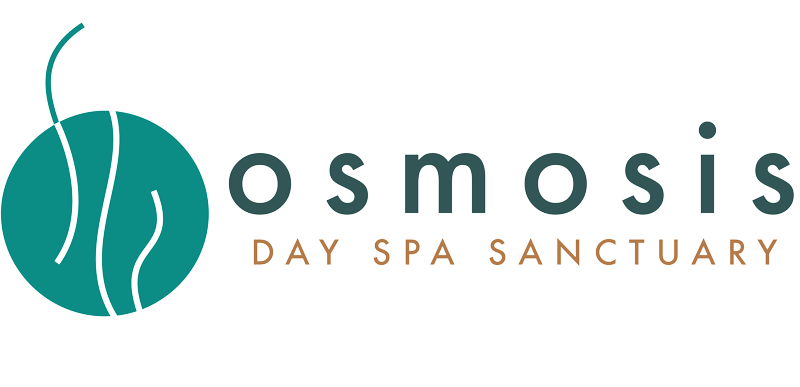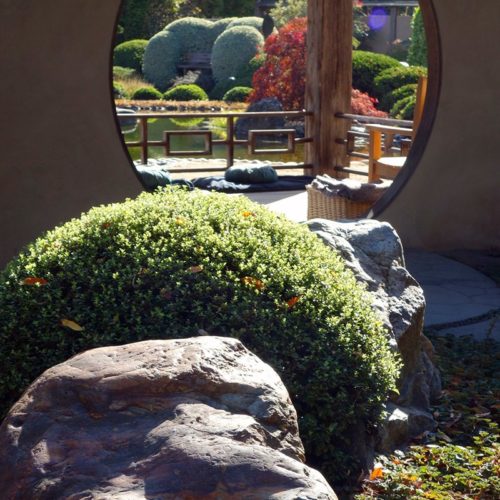The Meditation Garden at Osmosis tells the story of the Ox and the Ox Herder, a 12th century Zen parable that illustrates the path to spiritual enlightenment. The story, which originates from China (and has been featured in temples in Japan as well), also reflects more broadly on the process of learning and growth, whether spiritual teachings or the practical lessons of the everyday world.
In the story, which features ten stages, the Ox is understood to symbolize one’s true nature — at times unruly, but ultimately seeking tranquility and equanimity. At Osmosis, these ten stages are represented in the abstract through various features of rocks and stones, inviting our guests to contemplate their own paths of intellectual engagement and spiritual fulfillment:
Stage One: The Search for the Ox
The first stage is represented by a singular tall stone, depicting the Ox Herder on his own. Though the ox is nowhere to be seen, his search suggests that he has set his intention along a certain path.
Stage Two: Traces of the Ox
A series of small round pebbles are set into gravel, symbolizing the Ox Herder’s first assurance that the Ox is present, even if he cannot yet be found. These traces affirm the path that the Ox Herder has set out on.
Stage Three: Glimpsing the Ox
Along the route, viewers will find an old pickup truck (a link to the past of the land on which Osmosis now sits) and near it, a stone standing in isolation representing the Ox and a smaller stone that is the Herder who has caught his first glimpse, albeit at a great distance. The Ox’s head is turned away from the Herder, suggesting that he senses the Herder’s presence, but responds without fear (and perhaps with arrogance).
Stage Four: Finding the Ox
Here, the large stones of the Ox and Herder are closer, yet distance — and the viewer’s path — remains between the two. Though the Herder is closer to capturing the Ox, the balance of power still rests with the beast.
Stage Five: Taming the Ox
Set in an area of raked gravel, two large stones show the Ox’s resistance as the Herder begins to impose his will. The placement of the stones suggests the Herder’s intense exertion, as if straining every sinew in his body, while the Ox is turned as if trying to escape and break free.
Stage Six: Riding the Ox
Set in an open space, the proportion of stones shifts, as the Ox Herder becomes larger, suggesting his dominance. In paintings, this stage is often depicted with the Herder riding on the Ox’s back, looking backwards while playing a flute, suggesting his complete control and ease.
Stage Seven: The Ox is Forgotten
Continuing along the path, viewers will once again find a single tall upright stone, which symbolizes the Herder who no longer needs the Ox to define his identity. He breaks free of all attachments he had to the Ox.
Stage Eight: Oblivion
Represented by the pond itself, this stage illuminates the Herder’s catharsis as he realizes that, just as the Ox does not define his identity, he exists within himself as part of a greater whole, just as a tree exists within the larger forest.
Stage Nine: The Return to Ground and Origin
Our stream becomes the ninth stage, symbolizing an understanding and acceptance of things as they are. The moving water connects the height of the hills and the depths of the pond, suggesting our own nourishing relationships with the landscape and environment around us.
Stage Ten: Entering the Market with Open Hands
In this final stage, represented by two large stones, the Herder has returned to society enhanced by the knowledge he has gained. The two stones suggest teacher and student, as the Herder is dedicated not to retaining knowledge for his own personal use, but to serving as an instrument by which to support the learning and fulfillment of others.
Though this parable is centuries old, we invite our visitors — of any faith or spiritual practice — to consider how it may resonate within our own daily lives as you journey on your own path to healing and learning. For further insight into this rich story and its depiction at Osmosis, we invite you to check out our commemorative book The Osmosis Gardens or read Myosho Ginny Mathews’ essay “The Parable and You: The Ox and the Ox-Herder in the 21st Century,” excerpted on our blog.
Flowerevolution Month 6: Interview with Michael Stusser, owner of Osmosis Day Spa in Sebastopol, CA


